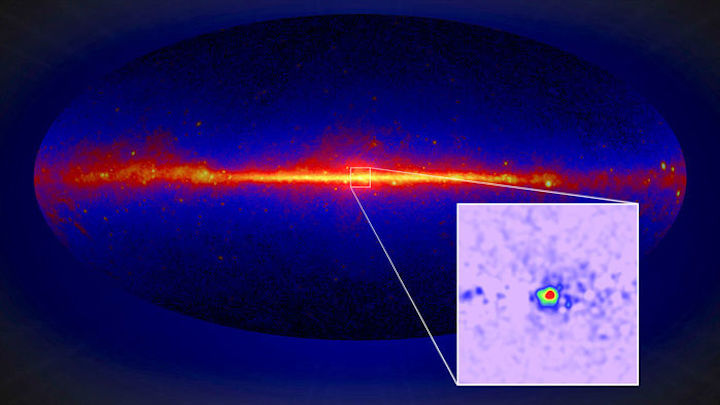13.11.2019

NASA’s Fermi Gamma-ray Space Telescope has mapped the entire sky and found a faint, unexplained excess of gamma rays (inset) coming from around the center of our galaxy.
NASA/DOE/FERMI LAT COLLABORATION; T. LINDEN/UNIVERSITY OF CHICAGO
A controversial dark matter claim may be making a comeback. Three years ago, a team of particle astrophysicists appeared to nix the idea that a faint glow of gamma rays in the heart of our Milky Way Galaxy could be emanating from dark matter—the mysterious stuff whose gravity holds the galaxy together. But the conclusion that the gamma rays come instead from more ordinary sources, such as spinning neutron stars known as pulsars, may have been too hasty, the team reports in a new study. So the dark matter hypothesis may be alive and well after all.
“I’m sure that some people will start to think about dark matter interpretations [of the glow] again,” says Dan Hooper, a theorist at the Fermi National Accelerator Laboratory (Fermilab) in Batavia, Illinois, who was not involved in either study. Others are less sure there will be such a revival.
Hooper and his Fermilab colleague Lisa Goodenough discovered the unexplained gamma ray glow in 2009 while studying data from NASA’s orbiting Fermi Gamma-ray Space Telescope. Dubbed the galactic center excess, that glow enshrouds the heart of the galaxy. Draw a circle on the sky around the galactic center 30° in radius and the excess will account for 2% of all gamma rays coming from within it.
Hooper and Goodenough immediately suggested the glow could be evidence of dark matter. Physicists think the entire Milky Way Galaxy lies embedded in a vast cloud of dark matter, like the swirl of color within a marble, with the dark matter densest in the middle. And theory generally suggests that, rarely, when two dark matter particles collide they should annihilate each other to produce ordinary particles, such as the observed high energy photons, or gamma rays. The discovery of the galactic center excess touched off a frenzy of “model building,” in which theorists tried to concoct specific theories of dark matter that would fit the data.
However, the gamma rays could also come from less exotic sources like pulsars. In 2015, Tracy Slatyer, a particle astrophysicist at the Massachusetts Institute of Technology (MIT) in Cambridge, and colleagues appeared to make the case that all of the galactic center excess could come from a population of pulsars that are too faint for Fermi to resolve individually.
The argument was tricky. To see the faint gamma ray excess by itself, the researchers had to first subtract out contributions from a half-dozen other known sources. These include the bright disk of the galaxy, sources from beyond the galaxy, and the vast “Fermi bubbles,” lobes of gamma ray emission that the space telescope discovered on either side of the plane of our galaxy. That left a bull’s-eye–like glow in the center of the galaxy. Then, to tell whether the excess was coming from dark matter or pulsars, the researchers analyzed not the spatial distribution of the light, but something far more subtle: how grainy it is.
The digital image of the glow consists of about 12,000 pixels, each containing a handful of gamma ray photons, with the number varying from pixel to pixel. If the photons come from dark matter, which should be distributed smoothly in the galaxy, those variations should have a predictable size. If they come from point sources like pulsars, the variations should be bigger and the picture should be grainier. That’s because the number of pulsars in each pixel will also vary, contributing extra pixel-to-pixel variations.
In 2015, Slatyer’s team reported that the picture was so grainy that it was most likely produced by pulsars. The study had a big effect. Citations to Hooper and Goodenough’s original paper fell from more than 120 in 2015 to just over 40 last year.
Now, however, Slatyer and MIT postdoc Rebecca Leane have found a problem with the different spatial patterns or templates used to subtract the other contributions to the gamma ray flux. In particular, if the templates for the different types of point sources aren’t right, then the analysis tends to drastically underestimate the smoother dark matter signal, tests on simulated data show. “If we don’t model things correctly, we seem to be removing dark matter,” Leane says. In fact, when the researchers injected a simulated dark matter signal into the real Fermi data, their analysis did not necessarily find it, they report in a paper in press at Physical Review Letters. So a real dark matter signal could be in the data and they may have missed it, Leane explains.
Will particle theorists start to puzzle over the galactic center excess again? Hooper hopes they will. “Whether 5% or 50% or 90% of the people who lost interest will come back, I don’t know,” he says. Others say the galactic center excess will likely remain too ambiguous to analyze decisively. “I don’t see anything so far that can’t be explained with [conventional] astrophysics,” says Glennys Farrar, a theorist at New York University in New York City.
The real lesson of the new work is that physicists need to better understand the ordinary but complicated astrophysics in the center of the galaxy, says Mattia Di Mauro, an astroparticle physicist at NASA’s Goddard Space Flight Center in Greenbelt, Maryland, who works on the Fermi space telescope. “But I’m scared that it will revive only the interest in dark matter.”
Quelle: AAAS
